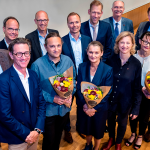On 4 June four new Clinical Academic Group names will be announced. The groups are the first collaborations between researchers and practitioners after Region Zealand and DTU joined UCPH and the Capital Region of Denmark’s translational initiative.
The four new Clinical Academic Groups (CAGs) will – within their individual fields of research – combine clinical practice, research, education and skills development across the partner organisations. On the day of the announcement, the members of the new CAGs will present their upcoming work and how it will benefit patients.
The chairmen of the regional councils in Region Zealand and the Capital Region of Denmark will also be present on 4 June, where they will talk about their visions for the collaboration.
The presentation of the groups and their fields of work will take place in the Jerne Auditorium in the Maersk Tower, and everyone is welcome.
Health-Promoting Collaboration
The Greater Copenhagen Heath Science Partners (GCHSP) already comprises eight CAGs, soon 12. The collaboration facilitates a strengthening of research, innovation and clinical development in Eastern Denmark. Together the four partner organisations support larger projects and priorities within health research and thus promote health among patients and citizens.
But UCPH, the Technical University of Denmark, Region Zealand and the Capital Region of Denmark do not just collaborate within the auspices of GCHSP. E.g. on 1 February this year they launched a collaboration on Personalised Medicine in Eastern Denmark, which has at its disposal a joint data centre, a genome centre and a biobank. This collaboration also focusses on future patient treatment. And there is great potential for cooperation between GCHSP and Personalised Medicine in Eastern Denmark.
About GCHSP and the CAGs
Central to GCHSP is the formation of a series of CAGs within areas of great potential. A CAG is a strong, research-oriented collaboration structure between researchers and clinicians in hospitals, universities and other collaborators.








